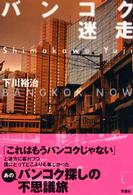- ホーム
- > 洋書
- > 英文書
- > Architecture
Full Description
Increasing urbanization and increasing urban density put enormous pressure on the relationships between people and place in cities. Built environment professionals must pay attention to the impact of people-place relationships in small- to large-scale urban initiatives. A small playground in a neighborhood pocket park is an example of a small-scale urban development; a national environmental policy that influences energy sources is an example of a large-scale initiative. All scales of decision-making have implications for the people-place relationships present in cities. This book presents new research in contemporary, interdisciplinary urban challenges, and opportunities, and aims to keep the people-place relationship debate in focus in the policies and practices of built environment professionals and city managers. Most urban planning and design decisions, even those on a small scale, will remain in the urban built form for many decades, conditioning people's experience of their city. It is important that these decisions are made using the best available knowledge.
This book contains an interdisciplinary discussion of contemporary urban movements and issues influencing the relationship between people and place in urban environments around the world which have major implications for both the processes and products of urban planning, design, and management. The main purpose of the book is to consolidate contemporary thinking among experts from a range of disciplines including anthropology, environmental psychology, cultural geography, urban design and planning, architecture and landscape architecture, and the arts, on how to conceptualize and promote healthy people and place relationships in the 21st-century city. Within each of the chapters, the authors focus on their specific areas of expertise which enable readers to understand key issues for urban environments, urban populations, and the links between them.
Contents
Introduction: The Power of Cities on People-Place Relationships Section 1: Vibrant Cities Ch 1. Self-conscious and unselfconscious placemaking in the city Ch 2. Using places / exchanging places Ch 3. Festival Bodies: The Role of the Senses and Feelings in Place-Making Practices Ch 4. A Sound Understanding of Healthy Cities Ch 5. Art, communities and housing form: A practitioner's perspective Section 2: Diverse Cities Ch 6. Pushing diversity beyond recognition Ch 7. Diversity in density: Encouraging participation in higher density living Ch 8. Knowing their place: Children, young people and cities Ch 9. Exercise space planning and design for an aging society: A case study of space, exercise behaviour and cognitive function of older women in Taiwan Ch 10. Culture, citizenship and the practice of place-making Section 3: Equitable Cities Ch 11. The Experience of place and displacement in the 21st century city Ch 12. Propositions for more just urban public spaces Ch 13. Place-based activism: Out of the frying pan of citizen disengagement or into the fire of territorial localism? Ch 14. Morphing paradise ideology, culture and planning in Bali Ch 15. Consuming heritage or the end of tradition: Challenges in the transition from vernacularism to globalization Ch 16. The technological infrastructure of place Ch 17. Socio-ecological dimensions: People, place and technology Ch 18. Overcrowding and domestic use of public space Ch 19. Tel Aviv: Making place through technology Ch 20. Web 2.0 social media: Supporting people-place relationships Section 5: Resilient Cities Ch 21. Place Attachment, well-being and resilience Ch 22. Putting people first in place-based urban post-disaster recovery Ch 23. Rebuilding after disaster: People, processes and five per cent technology Ch 24. Making place by making things again? How artisanal makers are reshaping place in post-industrial Detroit and Newcastle Ch 25. Resilience in a warming climate: Public place-making for health and wellbeing in hot cities Ch 26. Urban Greenspace: Places supporting urban resilience Conclusion: Meeting the demands for change, adaptation and innovation in 21st Century cities








